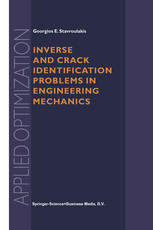

Most ebook files are in PDF format, so you can easily read them using various software such as Foxit Reader or directly on the Google Chrome browser.
Some ebook files are released by publishers in other formats such as .awz, .mobi, .epub, .fb2, etc. You may need to install specific software to read these formats on mobile/PC, such as Calibre.
Please read the tutorial at this link: https://ebookbell.com/faq
We offer FREE conversion to the popular formats you request; however, this may take some time. Therefore, right after payment, please email us, and we will try to provide the service as quickly as possible.
For some exceptional file formats or broken links (if any), please refrain from opening any disputes. Instead, email us first, and we will try to assist within a maximum of 6 hours.
EbookBell Team

4.4
42 reviewsInverse and crack identification problems are of paramount importance for health monitoring and quality control purposes arising in critical applications in civil, aeronautical, nuclear, and general mechanical engineering. Mathematical modeling and the numerical study of these problems require high competence in computational mechanics and applied optimization. This is the first monograph which provides the reader with all the necessary information. Delicate computational mechanics modeling, including nonsmooth unilateral contact effects, is done using boundary element techniques, which have a certain advantage for the construction of parametrized mechanical models. Both elastostatic and harmonic or transient dynamic problems are considered. The inverse problems are formulated as output error minimization problems and they are theoretically studied as a bilevel optimization problem, also known as a mathematical problem with equilibrium constraints. Beyond classical numerical optimization, soft computing tools (neural networks and genetic algorithms) and filter algorithms are used for the numerical solution.
The book provides all the required material for the mathematical and numerical modeling of crack identification testing procedures in statics and dynamics and includes several thoroughly discussed applications, for example, the impact-echo nondestructive evaluation technique.
Audience: The book will be of interest to structural and mechanical engineers involved in nondestructive testing and quality control projects as well as to research engineers and applied mathematicians who study and solve related inverse problems. People working on applied optimization and soft computing will find interesting problems to apply to their methods and all necessary material to continue research in this field.